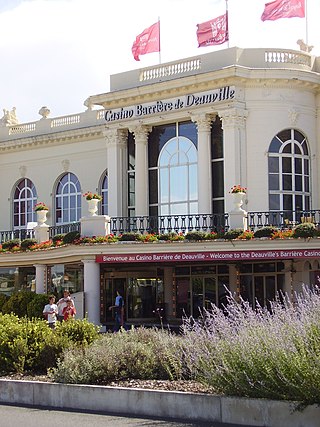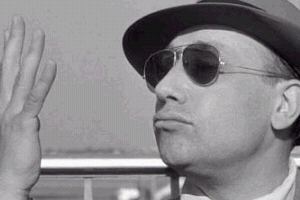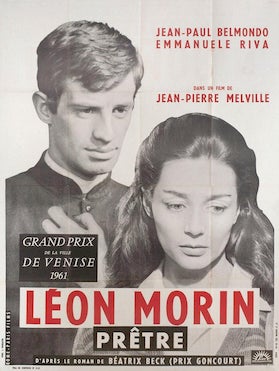
A Man and a Woman is a 1966 French romantic drama film directed by Claude Lelouch and starring Anouk Aimée and Jean-Louis Trintignant. Written by Pierre Uytterhoeven and Lelouch, the film concerns a young widow and widower who meet by chance at their children's boarding school and whose budding relationship is complicated by the memories of their deceased spouses. The film is known for its lush photography, which features frequent segues among full color, black-and-white, and sepia-toned shots, and for its music score by Francis Lai.

The New Wave, also called the French New Wave, is a French art film movement that emerged in the late 1950s. The movement was characterized by its rejection of traditional filmmaking conventions in favor of experimentation and a spirit of iconoclasm. New Wave filmmakers explored new approaches to editing, visual style, and narrative, as well as engagement with the social and political upheavals of the era, often making use of irony or exploring existential themes. The New Wave is often considered one of the most influential movements in the history of cinema.

Deauville is a commune in the Calvados department, Normandy, northwestern France. Major attractions include its harbour, race course, marinas, conference centre, villas, Grand Casino, and sumptuous hotels. The first Deauville Asian Film Festival took place in 1999. Deauville is one of the most prestigious seaside resorts in all of France. As the closest seaside resort to Paris, the city and its region of the Côte Fleurie has long been home to French high society's seaside houses and is often referred to as the Parisian riviera.

Jean-Pierre Grumbach, known professionally as Jean-Pierre Melville, was a French filmmaker. Considered a spiritual father of the French New Wave, he was one of the first fully-independent French filmmakers to achieve commercial and critical success. His works include the crime dramas Bob le flambeur (1956), Le Doulos (1962), Le Samouraï (1967), and Le Cercle Rouge (1970), and the war films Le Silence de la mer (1949) and Army of Shadows (1969).

Le Samouraï, is a 1967 neo-noir crime thriller film written and directed by Jean-Pierre Melville and starring Alain Delon, François Périer, Nathalie Delon, and Cathy Rosier. A Franco-Italian production, it depicts the intersecting paths of a professional hitman (Delon) trying to find out who hired him for a job and then tried to have him killed, and the Parisian commissaire (Périer) trying to catch him.

Jules and Jim is a 1962 French New Wave romantic drama film directed, produced and co-written by François Truffaut. Set before and after World War I, it describes a tragic love triangle involving French Bohemian Jim, his shy Austrian friend Jules, and Jules's girlfriend and later wife Catherine.

Le Cercle Rouge is a 1970 crime film set mostly in Paris. It was directed by Jean-Pierre Melville and stars Alain Delon, Bourvil, Gian Maria Volonté, François Périer and Yves Montand. It is known for its climactic heist sequence which is about half an hour in length and has almost no dialogue.
Jacques Becker was a French film director and screenwriter. His films, made during the 1940s and 1950s, encompassed a wide variety of genres, and they were admired by some of the filmmakers who led the French New Wave movement.
Henri Decaë was a French cinematographer who entered the film industry as a sound engineer and sound editor. He was a photojournalist in the French army during World War II. After the war he began making documentary shorts, directing and photographing industrial and commercial films. In 1947 he made his first feature film.

Le Silence de la mer is a 1949 French drama film by Jean-Pierre Melville, his directorial debut. It is based on the 1942 book of the same name written by Vercors. Set during WWII in occupied France, the story concerns the relationship of a Frenchman and his niece with a German lieutenant, Werner von Ebrennac, who is billetted in their house.

Le Doulos is a 1962 French crime film written and directed by Jean-Pierre Melville, adapted from the novel of the same name by Pierre Lesou. It was released theatrically as The Finger Man in the English-speaking world, but all video and DVD releases have used the French title. Intertitles at the beginning of the film explain that the French title refers both to a kind of hat and to the slang term for a police informant.

The Good Thief is a 2002 crime thriller film written and directed by Neil Jordan. It is a remake of the French film Bob le flambeur (1955) by Jean-Pierre Melville. The film, shot in both Monaco and Nice, France, follows a heroin-addicted retired thief through the setup and completion of one last job.

Maurice Ronet was a French film actor, director, and writer.

Les Enfants terribles is a 1950 French film directed by Jean-Pierre Melville, with a screenplay adapted by Jean Cocteau from his 1929 novel of the same name about the tangled relationship of a close brother and sister.

Le deuxième souffle is a 1966 French crime-thriller film directed by Jean-Pierre Melville and starring Lino Ventura, Paul Meurisse, Raymond Pellegrin, and Christine Fabréga.
Roger Duchesne was a French film actor. He appeared in 30 films between 1934 and 1957, but is best remembered for playing the lead in Bob le flambeur (1956). He was the first husband of French film actress Yvette Lebon.

Two Men in Manhattan is a 1959 French film noir written and directed by Jean-Pierre Melville. It stars Melville and Pierre Grasset as two French journalists in New York City who are searching for a missing United Nations diplomat. Although Melville occasionally played bit parts in the films of other directors, Two Men in Manhattan was his only starring role, and the only time he acted in one of his own films, other than providing the off-screen narration for Bob le flambeur (1956).

Léon Morin, Priest is a 1961 French drama film directed by Jean-Pierre Melville. It was adapted by Melville from Béatrix Beck's novel The Passionate Heart, which won the Prix Goncourt in 1952. Set during WWII in Occupied France, the film stars Emmanuelle Riva as a jaded, lapsed Catholic mother and widow of a Jewish husband, who finds herself falling in love with a young, altruistic priest, played by Jean-Paul Belmondo.
Ginette Vincendeau is a French-born British-based academic who is a professor of film studies at King's College London.
Auguste Le Breton was a French novelist who wrote primarily about the criminal underworld. His novels were adapted into several notable films of the 1950s, such as Rififi, Razzia sur la chnouf, Le rouge est mis and Le clan des siciliens. He wrote the dialogue for the noir film Bob le flambeur.















